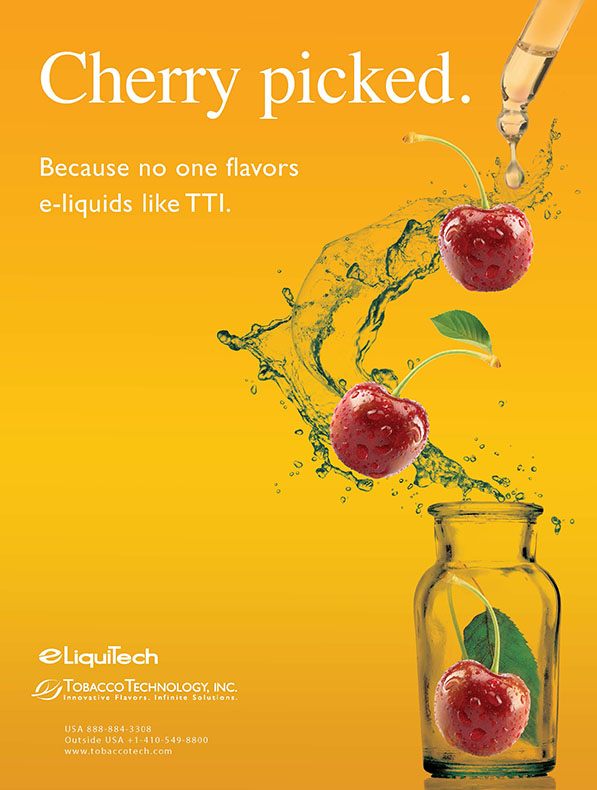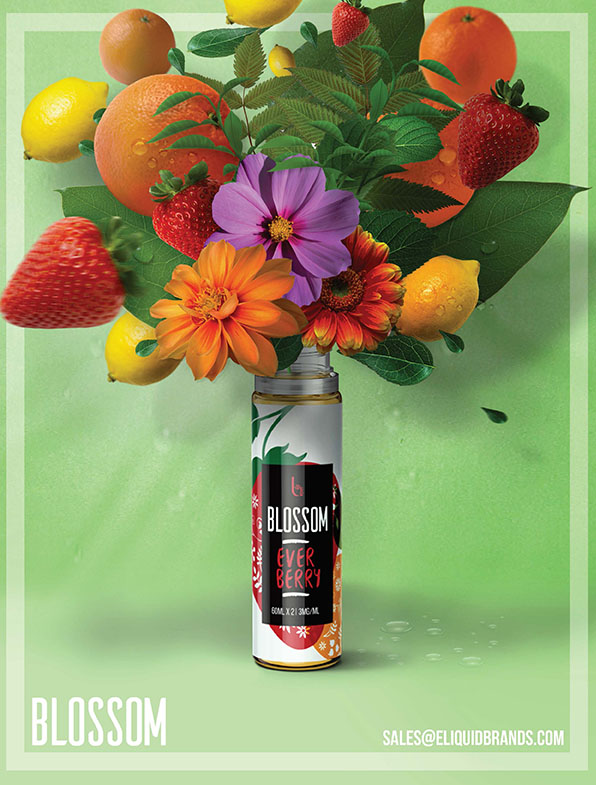PRIORITIZED ENFORCEMENT
The U.S. government has banned all nontobacco flavors in closed pod systems without a PMTA.
By Timothy S. Donahue
The new year had barely begun. On Jan. 2, the U.S. Food and Drug Administration (FDA) finalized its policy for banning flavors in some vapor products. It could have been much worse. The FDA is only currently enforcing the flavor ban in closed pod systems (prefilled tanks with separate batteries), so the industry should still survive. “We have to protect our families,” U.S. President Donald Trump said about the ban. “At the same time, it’s a big industry, [and] we want to protect the industry.”
The new regulatory guidelines came just weeks after Trump approved raising the federal minimum age for buying and consuming tobacco products from 18 to 21. Trump signed the new tobacco minimum-age language into law Dec. 20 as part of a federal spending bill. The flavored pod ban is a step back from the nearly complete flavored vape ban the Trump administration initially expressed back in September as lung injuries from vaping were on the rise.
The regulations, which went into effect on Feb. 6, require that companies stop manufacturing or distributing, or selling “any flavored, cartridge-based ENDS [electronic nicotine-delivery system] product (other than a tobacco-[flavored] or menthol-flavored ENDS product)” or face the risk of FDA enforcement actions. The rule does not include open-tank systems or completely self-contained, disposable products. Any product that markets toward “kids” or “youth” is also illegal.
The FDA defines an e-liquid cartridge as “any small, enclosed unit sealed or unsealed, designed to fit within or operate as part of an electronic nicotine delivery system (ENDS). Ray Keller, CEO of GoodCat Laboratories, a Naples, Florida-based e-liquid manufacturer, says he believes the FDA language was intended to delineate between a mod system and a small stick pod system. “The thought being there that the larger mod systems are too bulky[;] they’ll have to have a bottle [of e-liquid] with them,” explains Keller. “[Youth] can’t hide them as easily. The mod systems make a lot of vapor that you can’t really hide. So, I think that’s what they were trying to get at.”
Companies should be aware that the flavor ban DOES cover pod systems that are refillable and non-refillable, however, the FDA hasn’t been clear on how it will regulate refillable pods that do not contain e-liquid, according to Agustin Rodriguez, an attorney with Troutman-Sanders, a law firm with 12 offices across the U.S. that specializes in the vapor and tobacco industries. “Because empty refillable pods don’t yet contain a flavor, it is our expectation that [the] FDA will not prioritize refillable pods that contain no liquid unless the particular product or the circumstances of its sale raise another regulatory concern beyond product format,” Rodriguez said.
Companies should also be aware that flavor-ban guidance does not affect the existing deadline for the filing of premarket tobacco product applications (PMTAs) with the FDA, Rodriguez explains. Manufacturers must submit a PMTA for their e-cigarette and vaping products by May 12. “From that date, every nicotine vapor product for sale on the market (whether an open or closed system and regardless of flavor profile) must be the subject of a PMTA and will be permissible for sale for another period of 12 months so long as [the] FDA takes no negative action with respect to that PMTA,” Rodriguez said. “While the guidance may lead to additional legal actions by [the] industry to attempt to delay the May 2020 implementation date, we are strongly counseling tobacco product manufacturers not to rely solely on a litigation strategy with respect to the question of PMTAs.”
Keller says that flavored disposable systems aren’t currently being regulated by the FDA, but if the rule is abused (and youth start using flavored disposables), the FDA can change it. “Everybody’s going to try to get by the rules,” he says. “The people selling; the people buying it; they’re all going to try and get around this. And then on May 13th, if there’s no PMTA, it’s not on the market anyway.”
The PMTA requirement will greatly impact vape shops that produce their own e-liquids in-house. These shops are considered manufacturers and must submit PMTAs in order to continue to sell their products while the FDA reviews their PMTA application, according to the FDA. “A vape shop that is in the business of manufacturing, by mixing nicotine and flavors, has a decision that it has to make about what business it wants to be in going forward,” said Mitch Zeller, director of the FDA’s Center for Tobacco Products. “If they are involved in the manufacturing process, they are subject to the law.”
The FDA has stated that it advises retailers and wholesalers to adopt practices to ensure compliance with the prohibition on marketing or selling flavored ENDS products. The agency stated that it recognizes that retailers and wholesalers may need to store unsold products beyond the Feb. 6 deadline until products can be returned to a distributor or manufacturer.
It’s hard to predict what the vapor market will look like post-May 12, but there is a high risk of significant confusion over what products are lawfully being sold. This is because the FDA does not publish products that are the subject of a PMTA, states Rodriguez. “The opportunity for the industry is to come up with ways to assure the public that the products still for sale are lawfully being made available,” he says. “We are working with our clients on ways to address that opportunity.”
On May 13, the day after the PMTA deadline, Keller thinks that most companies are going to be out of business. He says there’s also the possibility that there is a mass exodus from the market before the May 12 deadline. He also predicts a rise in the availability of illegal products. “I just don’t see how anybody except the largest players are going to be able to put this [PMTA] together and have it handed over in completion on May 12,” he says. “So, I think a lot of shops are going to close. I think the internet business will pick up. At first, there’s going to be some black market activity. But that’s going to happen any time prohibition gets involved, and no matter what the product, there’s always going to be a little black market activity.”
The ban was not met with enthusiasm from anti-vaping groups. Gary Reedy, chief executive of the American Cancer Society, called it “a hollowed-out policy that will allow the tobacco industry to continue to attract kids to a lifetime of nicotine addiction.” Matt Myers, president of the Campaign for Tobacco-Free Kids, said that “the evidence indicates that if menthol e-cigarettes are left on the market, kids will shift to them. Decades of experience with menthol cigarettes demonstrate that menthol appeals to kids.”
Many vaping industry insiders also don’t agree with the FDA’s approach to youth use. They say a flavor ban (other than tobacco-related flavors) simply won’t work and better options are available. Flavors aren’t the issue; it’s the nicotine, according to Keller. He says that youth aren’t using vapor products because they like the strawberry or the watermelon taste; they want the nicotine. “In essence, I think what this is going to do is it’s just going to teach [kids] to like tobacco flavors. Right? It’s an acquired taste,” he explains. “They’re going to get used to it. It’s just like drinking coffee. Remember your first cup of coffee? It wasn’t really that good and now I can’t drink enough black coffee.”
The amount of nicotine allowed in vapor products is also a potential issue, according to Keller. With some products offering 50 mL of nicotine or more, users get a “buzz” instead of just satisfaction. “You have to take that buzz away. If you have a 50 mL mix, it’s going to spin your head a little bit,” he says. “Take that buzz away and I think you would have a better chance of quitting rather than just putting it down and giving up. But now, they’re going to start using other products and other flavors. Maybe tobacco becomes popular or they switch to disposable devices. There are better options than banning flavors to end the uptick in youth use.”
Tony Abboud, executive director at the Vapor Technology Association (VTA), a vapor industry advocacy group, explains that his organization doesn’t see flavor bans as the appropriate approach to youth use either. He says the current ban could easily lead to a domino effect that will wipe out the broader industry.
“It is safe to say that the opponents of public health will not stop until they ban all flavors and we will not rest in our efforts to defend and preserve flavor options for adult smokers that are desperately trying to quit smoking,” Abboud wrote in an email. “We have fought just about every battle and have won many. But, as with all things, we maintain a steely-eyed focus on winning the war and creating the regulatory framework for a well-regulated industry filled with a diverse array of products and flavors to give adult consumers the choices they are demanding and the choices that they need.
Sidebar
Tempered expectations
It was like a flashback to 1994. In early February, The House Energy and Commerce oversight and investigations subcommittee grilled the CEOs of Juul Labs, Reynolds American (RAI) and NJOY, as well as the presidents of Logic Technology Development and Fontem U.S. It was reminiscent of when, in 1994, the CEOs from seven major tobacco companies testified before Congress about the marketing tactics for tobacco products. The tension in the rooms was also similar.
Ryan Nivakoff, CEO of NJOY, reminded lawmakers about comments from former U.S. Food and Drug Administration (FDA) Commissioner Scott Gottlieb that support the harm reduction of vapor products. “[Gottlieb] said: ‘If you can fully switch every currently addicted adult smoker who is using combustible tobacco products onto e-cigarettes, you will have a profound impact on public health,’” said Nivakoff. “The National Academies of Sciences, Engineering, and Medicine has said: ‘complete switching from combustible tobacco cigarettes to e-cigarettes would be expected to reduce tobacco-related health risk.’”
For more than two hours, lawmakers on the House Energy and Commerce Subcommittee on Oversight and Investigations asked questions ranging from marketing strategies to how to curb youth usage of these products. K.C. Crosthwaite, CEO of Juul Labs, expressed his understanding of the serious need for companies to combat the uptick in youth use.
“I fully recognize that the opportunity for the millions of adult smokers who still use combustible cigarettes to have an alternative is at risk if we don’t address this issue,” K.C. Crosthwaite, Juul’s CEO, said. “We are focused on combating underage access because I know it puts it all at risk if we don’t make progress here.”
Legislators also wanted to understand the possible health effects vapor products pose to consumers and the role each company sees itself playing in the ongoing effort to curb the nation’s uptick of youth use. Antoine Blonde, president of Fontem, said the company had a detailed youth access prevention program and maintained efforts to safeguard its products from youth.
“Fontem uses industry-standard online age-gating and age-verification mechanisms to prevent youth access to its products online,” Blonde said. “For example, for all purchases through our website, Fontem relies on industry-standard age-verification technology that compares a potential purchaser’s information against records of trusted data sources to verify the age of the purchaser.”
Blonde said Fontem recognizes that there “may be” bad actors in the marketplace who attempt to purchase bulk quantities of its products through e-commerce websites in order to resell them (a practice often called “strawman sales”). “Fontem has always had policies in place to monitor for strawman sales and further is implementing a strict 4-stage standard to monitor site access for any potential strawman purchases on its online platform,” Blonde explained. “This standard will track registered adult consumers’ monthly order frequency of pods from its online platform and will flag potential strawman sales.”
The companies are said to represent nearly 97 percent of the $19.3 billion U.S. e-cigarette market, according to Rep. Diana DeGette, chairwoman of the subcommittee. That data only includes convenience store sales, and many industry insiders say the figure is grossly inaccurate. Vape shop sales are not included in the Nielsen data DeGette is citing.
“While consumers remain in the dark of the possible health consequences, these companies are making billions of dollars as they lure a new generation of young people into a lifetime of nicotine addiction,” DeGette, the chair of the oversight panel conducting the hearing, wrote in a press release.
Ricardo Oberlander, president and CEO of RAI, said the increase in youth vaping over the past two years, and serious health issues from illicit products, are now at the heart of a national discussion. “These issues are being discussed within families, by educators, and in state and local governments. They are being discussed in law enforcement communities, the White House, and here today, in the United States Congress,” he said, adding his company had submitted products for the PMTA. “Looking forward, [the] FDA’s premarket tobacco application process provides a pathway for vapor products aligned with public health priorities. We believe vapor products can be manufactured and marketed responsibly within this framework.”
Instead of imposing new requirements, such as “one size fits all” flavor bans that unfairly penalize responsible companies and limit consumer choice, Jerry Loftin, president of Logic, said that his company believes that regulators must strengthen the enforcement of existing requirements. “The [FDA] should immediately enforce premarket authorization requirements for all ENDS [electronic nicotine-delivery system] products currently on the market and take action against companies that make unauthorized modified risk or smoking cessation claims or who market their products in ways that are uniquely appealing to minors,” he said. “Failure to do so disadvantages companies that are acting responsibly and distorts the ENDS marketplace to the public detriment.”
In other congressional news, a bill was introduced in the U.S. Senate in late January that would charge e-cigarette manufacturers higher user fees, which fund many of the FDA’s regulatory activities. Six senators, led by Democrat Jeanne Shaheen, introduced the legislation. A corresponding bill led by Rep. Cheri Bustos has also been introduced in the House.
The Senate bill would raise the tobacco industry’s fees from $712 million to $812 million—the same increase as the Trump administration’s 2020 proposed budget. Vapor industry manufactures would be expected to pay fees based on their market share or risk fines and possibly even have products removed from the market. – VV staff

Timothy Donahue
Timothy S. Donahue is the co-founder and managing editor of Vapor Voice.
Tim spends much of his time on the road, attending conferences and interviewing industry representatives.
His networking skills, work ethic and quick mind are valuable assets to our diverse audience.



